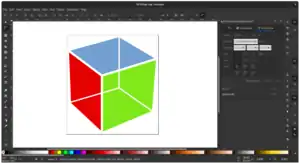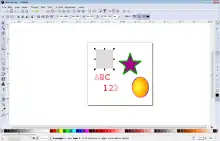Inkscape
Inkscape is a free and open-source vector graphics editor used to create vector images, primarily in Scalable Vector Graphics (SVG) format. Other formats can be imported and exported.[4]
 | |
 Inkscape 1.0 on Fedora 32 | |
| Initial release | November 2, 2003 |
|---|---|
| Stable release | 1.0.2[1] (January 17, 2021) [±] |
| Repository | |
| Written in | C++ with gtkmm, Python (extensions) |
| Operating system | FreeBSD Linux macOS Windows |
| Platform | IA-32 and x64 |
| Size | 81.6 MB |
| Available in | 90 languages[2] |
| Type | Vector graphics editor |
| License | GPLv3+[3] |
| Website | inkscape |
Inkscape can render primitive vector shapes (e.g. rectangles, ellipses, polygons, arcs, spirals, stars and 3D boxes) and text. These objects may be filled with solid colors, patterns, radial or linear color gradients and their borders may be stroked, both with adjustable transparency. Embedding and optional tracing of raster graphics is also supported, enabling the editor to create vector graphics from photos and other raster sources. Created shapes can be further manipulated with transformations, such as moving, rotating, scaling and skewing.
History
Inkscape began in 2003 as a code fork of the Sodipodi project.[5] Sodipodi, developed since 1999, was itself based on Raph Levien's Gill (GNOME Illustration Application).[6] One of the main priorities of the Inkscape project was interface consistency and usability by following the GNOME human interface guidelines.[5]
Inkscape FAQ interprets the word Inkscape as a compound of ink and -scape.[7][8]
Four former Sodipodi developers (Ted Gould, Bryce Harrington, Nathan Hurst, and MenTaLguY) led the fork, citing differences over project objectives, openness to third-party contributions, and technical disagreements. They said that Inkscape would focus development on implementing the complete SVG standard, whereas Sodipodi development emphasized developing a general-purpose vector graphics editor, possibly at the expense of SVG.[9]
Following the fork, Inkscape's developers changed the programming language from C to C++; adopted the GTK (formerly GIMP Toolkit) toolkit C++ bindings (gtkmm); redesigned its user interface, and added a number of new features.[10] Inkscape's implementation of the SVG standard, although incomplete, has shown gradual improvement.[11]
Since 2005, Inkscape has participated in the Google Summer of Code program.[12]
Up until the end of November 2007, Inkscape's source code repository was hosted by SourceForge. Thereafter it moved to Launchpad.[13] In June 2017, it moved to GitLab.[14]
Features
Object creation

Inkscape workflow is based around vector objects. Tools allow manipulating primitive vector shapes: simple ones like rectangles, ellipses and arcs, as well as more complex objects like 3D boxes with adjustable perspectives, stars, polygons and spirals. Rendering feature that can create objects like barcodes, calendars, grids, gears and roulette curves (using the spirograph tool). These objects may be filled with solid colors, patterns, radial or linear color gradients and their borders may be stroked, both with adjustable transparency. All of those can be further edited by transformations—such as moving, rotating, scaling and skewing—or by editing paths.
Other tools allow creating Bézier curves, freehand drawing of lines (pencil), or calligraphic (brush-like) strokes which support a graphics tablet.[15]
Inkscape is able to write and edit text with tools available for changing font, spacing, kerning, rotation, flowing along the path or into a shape. Text can be converted to paths for further editing. The program also has a layers (as well as an objects) feature that allows the user to organize objects in a preferred stacking order in the canvas. Objects can be made visible/invisible and locked/unlocked through these features.
Symbol libraries enable Inkscape to use existing symbols like logic-gate symbols or DOT pictograms. Additional libraries can be included by user.[16]
Inkscape supports image tracing, the process of extracting vector graphics from raster sources.
Clones are child objects of an original parent object. Different transformations can be applied to them, such as: size, position, rotation, blur, opacity, color and symmetry. Clones are updated live whenever the parent object changes.
Object manipulation
Every object in the drawing can be subjected to arbitrary affine transformations: moving, rotating, scaling, skewing and a configurable matrix. Transformation parameters can be specified numerically. Transformations can snap to angles, grids, guidelines and nodes of other objects, or be aligned in specified direction, spaced equally, scattered at random.
Objects can be grouped together. Groups of objects behave similarly to objects. Objects in a group can be edited without having to ungroup them first.
The Z-order determines the order in which objects are drawn on the canvas. Objects with a high Z-order are drawn on top of objects lower in the Z-order. Order of objects can be managed either using layers, or by manually moving the object up and down in the Z-order. Layers can be locked or hidden, preventing modifying and accidental selection.
The Create Tiled Clones tool allows symmetrical or grid-like drawings using various plane symmetries.
Appearance of objects can be further changed by using masks and clipping paths, which can be created from arbitrary objects, including groups.
The style attributes are 'attached' to the source object, so after cutting/copying an object onto the clipboard, the style's attributes can be pasted to another object.
Operations on paths
Inkscape has a comprehensive tool set to edit paths (as they are the basic element of a vector file):
- Edit Path by Node tool: allows for the editing of single or multiple paths and or their associated node(s). There are four types of path nodes; Cusp (corner), Smooth, Symmetric and Auto-Smooth. Editing is available for the positioning of nodes and their associated handles (angle and length) for Linear and Bézier paths or Spiro curves. A path segment can also be adjusted by dragging (left click + hold). When multiple nodes are selected, they can be moved, scaled and rotated using keyboard shortcut or mouse controls.[17] Additional nodes can be inserted into paths at arbitrary or even placements, and an effect can be used to insert nodes at predefined intervals. When nodes are deleted, the handles on remaining ones are adjusted to preserve the original shape as closely as possible.
- Tweak tool (sculpting/painting): provides whole object(s) or node editing regions (parts) of an object. It can push, repel/attract, randomize positioning, shrink/enlarge, rotate, copy/delete selected whole objects. With parts of a path you can push, shrink/enlarge, repel/attract, roughen edges, blur and color. Nodes are dynamically created and deleted when needed while using this tool, so it can also be used on simple paths without pre-processing.
- Path-Offsets; Outset, Inset, Linked or Dynamic: can create a Linked or Dynamic (unlinked) Inset and or an Outset of an existing path which can then be fine tuned using the given Shape or Node tool. Creating a Linked Offset of a path will update whenever the original is modified. Making symmetrical (i.e., picture frame) graphics easier to edit.
- Path-Conversion; Object to Path: conversions of Objects; Shapes (square, circle, etc.) or Text into paths.
- Path-Conversion; Stroke to Path: conversions of the Stroke of a shape to a path.
- Path-Simplify: a given path's node count will reduce while preserving the shape.
- Path-Operations (boolean operations): use of multiple objects to Union, Difference, Intersection, Exclusion, Division and Cut Path.
Inkscape includes a feature called Live Path Effects (LPE), which can apply various modifiers to a path. Envelope Deformation is available via the Path Effects and provides a perspective effect. There are more than a dozen of these live path effects. LPE can be stacked onto a single object and have interactive live on canvas and menu-based editing of the effects.
File formats
Inkscape's primary format is SVG 1.1, meaning that it can create and edit with the abilities and within the constraints of this format. Any other format must either be imported (converted to SVG) or exported (converted from SVG). The SVG format is using the Cascading Style Sheets (CSS) standard internally. Inkscape's implementation of SVG and CSS standards is incomplete. Most notably, it does not support animation natively.[18] Inkscape has multilingual support, particularly for complex scripts. Formats that used the UniConvertor library are not supported beyond the 1.0 release. A workaround is to have a parallel installation of version 0.92.x.[19]
| Format Name | Import | Export |
|---|---|---|
| Adobe Illustrator Artwork (AI) | native | |
| CorelDRAW (CDR) | native | |
| Microsoft Visio Drawing (VSD) | native | |
| Portable Document Format (PDF) | native | native |
| compressed SVG (SVGZ) | native | |
| JPEG | native | |
| PNG | native | |
| GIF | native | |
| BMP | native | |
| Computer Graphics Metafile (CGM) | with UniConvertor | |
| Encapsulated Postscript (EPS) | with Ghostscript | native |
| PostScript (PS) | with Ghostscript | native |
| SK1 | with UniConvertor | |
| sketch | with extension | |
| Xfig (FIG) | with extension | |
| Flash XML Graphics (FXG) | native | |
| Hewlett-Packard Graphics Language (HPGL) | native | |
| HTML5 canvas element | native | |
| LaTeX (TeX) | native | |
| Synfig (SIF) | native | |
| Extensible Application Markup Language (XAML) | native |
Other features
- XML Editor for direct manipulation of the SVG XML structure
- Editing of Resource Description Framework (RDF), a World Wide Web Consortium (W3C) metadata information model
- Command-line interface, exposes format conversion functions and full-featured GUI scripting
- More than sixty interface languages
- Extensible to new file formats, effects and other features
- Mathematical diagramming, with various uses of LaTeX[20]
- Experimental support for scripting
- lib2Geom is now also external usable. 2Geom is a computational geometry library, originally developed for Inkscape. While developed for Inkscape it is a library that can be used from any application. It provides support for basic geometric algebra, paths, distortions, boolean operations, plotting implicit functions, non-uniform rational B-spline (NURBS) and more. 2Geom is free software released under LGPL 2.1 or MPL 1.1.[21][22]
Platform support
The latest version of Inkscape 1.0.x (and older line 0.92.x) is available for Linux, Windows 7+, and macOS 10.11-10.15 platforms.[23] Inkscape is packaged with AppImage, Flatpack, PPA and source by all major Linux distributions (including Debian, Ubuntu, Fedora, OpenSUSE) with GTK+ 3.24+ (0.92.x with GTK+ 2.20+ for older Linux).[24][25]
As of 2017, Wacom tablet support for GTK 3 is in a reviving project. Version 1.0.x includes GTK 3 and Wacom support depending necessary Wacom Linux or Unix driver. [26]
Release history
| Version | Release date | Notable Features | ||
|---|---|---|---|---|
| 0.35 | November 11, 2003 | Initial release of Inkscape based on Sodipodi 0.32, new keyboard shortcuts[27] | ||
| 0.36 | December 11, 2003 | GUI redesign and improved usability[28] | ||
| 0.37 | February 16, 2004[29] | Boolean path operations and path inset/outset, major code refactoring[30] | ||
| 0.38 | April 12, 2004[31] | Text kerning and letter spacing, multi-stage gradients[32] | ||
| 0.39 | July 20, 2004[33] | Markers, clones, and pattern fills[34] | ||
| 0.40 | November 30, 2004[35] | Multi-layer support, bitmap tracing (only greyscale), and text on path[36] | ||
| 0.41 | February 10, 2005 | Clone tiler tool and color bitmap tracing[37] | ||
| 0.42 | July 26, 2005 | Flowing text support, styling text spans, enhanced effects support, and the new gradient tool[38] | ||
| 0.43 | November 19, 2005 | Connector tool, collaborative editing, tablet pressure/angle sensitivity[39] | ||
| 0.44 | June 24, 2006 | Layers panel, support for clipping and masking, PDF export with transparency[40] | ||
| 0.45 | February 5, 2007 | Gaussian blur, pattern along path, new Undo History panel, improved bitmap tracing using simple interactive object extraction, color effects[41] | ||
| 0.46 | March 24, 2008 | Docking user interface, Paint Bucket, Tweak and 3D Box tools, Live Path Effects, support for most SVG filters, the ability to open PDF files, import from the Open Clip Art Library, and OpenType/PostScript and Type1 font support[42] | ||
| 0.47 | November 24, 2009 | Eraser tool (can slice paths), timed autosave, spiro splines interface for paths, auto-smooth nodes for paths, spellchecker for the text tool, new path effects like "sketch" and "hatches", new Python extensions like "alphabet soup" and "convert to Braille", basic support for SVG fonts[43] | ||
| 0.48 0.48.5 | August 23, 2010; July 2014 | Multipath node editing, improved text tool: subscript, superscript, numerical and preset inputs for text kerning, tracking and more text enhancements, new Airbrush (Spray) tool, LaTeX export with PDF / PS / EPS, JessyInk extension for creating presentations viewable in SVG-enabled web browsers[44][45][46][47][48][49] | ||
| 0.91 | January 30, 2015[50] | Switched from libnr to Cairo rendering library, which brought a significant rendering speed improvement.[51]Refactoring; Measure tool, new import/export formats, grayscale mode, alignment modes, Symbol library and support for Visio stencils, Guides can have labels, variable width strokes (PowerStroke).[52][53] | ||
| 0.92 | January 4, 2017[54] | Infrastructure Focus; Mesh gradients are now supported, several new path effects, default resolution changed from 90 dpi to 96 dpi to match the CSS standard.[55] | ||
| 0.92.1 | February 7, 2017 | Several bug fixes[56] | ||
| 0.92.2 | August 7, 2017 | Several bug fixes and batch converter 90 to 96 dpi[57][58] | ||
| 0.92.3 | March 11, 2018 | Snap package ready for Linux, Windows 32-bit and 64-bit and Windows 10 App ready, macOS release not ready yet, several bug fixes[59][60] | ||
| 0.92.4 | January 17, 2019 | Increased stability, bug fixes[61][62] | ||
| 0.92.5 | April 9, 2020 | Increased stability, bug fixes, extensions compatible to Python 2 and 3[63][64] | ||
| 1.0alpha | January 17, 2019 | Maintenance and optimization focus, see new roadmap with version 0.92 to 1.2,[65] GTK+ 3 Transition, Python 2 to 3[66][67][68][69][70][71] | ||
| 1.0beta1 | September 8, 2019 | Test case and documentation focus, MacOS Version Certified, Improved HiDpi and more[72] | ||
| 1.0beta2 | December 3, 2019 | Bug fixes, MacOS 10.10-10.15 Catalina Supported[73] | ||
| 1.0rc1 | April 9, 2020 | Bug fixes | ||
| 1.0 | May 4, 2020 | Stabilization focus[74] | ||
| 1.0.1 | September 6, 2020 | Bug fixes, experimental color-managed PDF export[75] | ||
| 1.0.2 | January 17, 2021 | Bug fixes, zoom with middle mouse click, lock canvas rotation[76] | ||
Legend: Old version Older version, still maintained Latest version Latest preview version Future release | ||||
Reception
TechRadar gave Inkscape a positive rating of four stars out of five. It lauded the wide range of editing tools and support for many file formats, but noted that the application's processing can be slow. It considered Inkscape to be a good free alternative to proprietary graphics editors such as Adobe Illustrator.[78] PC Magazine's review was rather mixed, giving the application three out of five. It criticized the interface's graphics and lack of optimization for stylus support, the application's poor interoperability with other graphics editors, unwieldy text formatting controls, and the quality of the Mac version. However, it did praise the ability to add custom filters and extensions, the Inkscape community's passion for creating and sharing them, and the precise path and placement tools. It found Inkscape to have limited uses in profession compared to Adobe Illustrator and CorelDRAW.[79] In its 2012 Best of Open Source Software Awards, InfoWorld gave Inkscape an award for being one of the best open-source desktop applications, commending its typographic controls and ability to directly edit the XML text of its documents.[80]
Gallery
 Dragonfly wing illustration
Dragonfly wing illustration Cathedral plan
Cathedral plan Gaming console
Gaming console Map of Italy in 1796.
Map of Italy in 1796. Floral drawing with Inkscape
Floral drawing with Inkscape Simple Smile created with Inkscape
Simple Smile created with Inkscape Manga drawing created with inkscape
Manga drawing created with inkscape Raster to vector comparison
Raster to vector comparison Structure of 6-Acetyldihydromorphine hydrochloride, Cas 63715-94-6.
Structure of 6-Acetyldihydromorphine hydrochloride, Cas 63715-94-6.
See also
- AutoCAD
- Comparison of vector graphics editors
- Create Project
- Libre Graphics Meeting
- List of free and open source software packages
- Open Clip Art Library
- Open Font Library
- Wikipedia tutorial: How to draw a diagram with Inkscape
References
- "Enjoy bug fixes in Inkscape 1.0.2 and try out Inkscape 1.1 alpha". The Inkscape Project. January 17, 2021. Retrieved January 19, 2021.
- "List of language files at time of release of version 0.92.3 - gitlab.com repository". Inkscape. March 8, 2018. Retrieved March 28, 2018.
- "COPYING in Inkscape source". Retrieved October 15, 2018.
- "Inkscape Features". Inkscape.org. Retrieved January 13, 2020.
- "FAQ | Inkscape". inkscape.org. Retrieved May 5, 2020.
How did Inkscape start? […] Inkscape was started as a fork of Sodipodi, in late 2003, by four Sodipodi developers: Bryce Harrington, MenTaLguY, Nathan Hurst, and Ted Gould. Our mission was creating a fully compliant Scalable Vector Graphics (SVG) drawing tool written in C++ with a new, more user friendly (GNOME Human Interface Guidelines (HIG) compliant) interface and an open, community-oriented development process.
- "Linux.com Interviews Lauris Kaplinski". Linux.com. September 24, 2001. Retrieved December 9, 2015.
- "FAQ". Inkscape Project. Retrieved February 10, 2016.
What does 'Inkscape' mean? [...] The name is made up of the two English words 'ink' and 'scape'. Ink is a common substance for drawings, and is used when the sketched work is ready to be permanently committed to paper, and thus evokes the idea that Inkscape is ready for production work. A scape is a view of a large number of objects, such as a landscape or ocean-scape, and thus alludes to the object-oriented nature of vector imagery.
- Compare -scape
- "Announcing new project (sodipodi mailing list)". November 6, 2003. Retrieved December 9, 2015.
- "Inkscape Sodipodi Comparison". Retrieved December 9, 2015.
- "Frequently asked questions - Inkscape Wiki". Wiki.inkscape.org. July 29, 2012. Retrieved November 9, 2012.
- "Google's Summer of Code". Inkscape wiki. Archived from the original on July 4, 2007.
- "Inkscape moving to Launchpad".
- "Inkscape moves to GitLab".
- "Inkscape tutorial: Calligraphy". inkscape.org. Retrieved December 26, 2019.
- "SymbolsDialog - Inkscape Wiki". wiki.inkscape.org. Retrieved July 3, 2016.
- "Inkscape Keyboard Layout". openclipart.org. creative commons. Retrieved May 3, 2016.
- "Animation". Inkscape. Retrieved June 18, 2017.
- "Release notes/1.0 - Inkscape Wiki". wiki.inkscape.org.
- "Extension repository". Inkscape Wiki. Retrieved October 22, 2009.
- "inkscape/lib2geom". December 18, 2019 – via GitHub.
- "Graphics Math Library 2geom's First Release Available For Use Beyond Inkscape | Inkscape". inkscape.org.
- "All Platforms for Inkscape 1.0". inkscape.org. Retrieved May 6, 2020.
- https://inkscape.org/news/2020/05/04/introducing-inkscape-10/
- https://inkscape.org/forums/beyond/inkscape-10-theming-guide/
- "Linux Tablet Driver Project Revived | Inkscape".
- Harrington, Bryce (November 11, 2003). "[Inkscape] Inkscape Release 0.35". inkscape-announce (Mailing list). Retrieved January 5, 2020.
- Gould, Ted (December 11, 2003). "[Inkscape] Inkscape 0.36 - "See, even a 5 year old can use it."". inkscape-announce (Mailing list). Retrieved January 9, 2020.
- Harrington, Bryce (February 16, 2004). "[Inkscape] Announcing Inkscape 0.37 Release". inkscape-announce (Mailing list). Retrieved January 9, 2020.
- "Download Inkscape 0.37 | Inkscape".
- Harrington, Bryce (April 12, 2004). "[Inkscape] Announcing Inkscape 0.38 Release". inkscape-announce (Mailing list). Retrieved January 9, 2020.
- "Download Inkscape 0.38.1 | Inkscape".
- Gould, Ted (July 20, 2004). "[Inkscape] Inkscape 0.39". inkscape-announce (Mailing list). Retrieved January 9, 2020.
- "Download Inkscape 0.39 | Inkscape".
- Harrington, Bryce (November 30, 2004). "[Inkscape] Announcing Inkscape 0.40 Release". inkscape-announce (Mailing list). Retrieved January 9, 2020.
- "Download Inkscape 0.40 | Inkscape".
- "Download Inkscape 0.41 | Inkscape".
- "Download Inkscape 0.42 | Inkscape".
- "Download Inkscape 0.43 | Inkscape".
- "Download Inkscape 0.44.1 | Inkscape".
- "Download Inkscape 0.45.1 | Inkscape".
- "Download Inkscape 0.46 | Inkscape".
- "Download Inkscape 0.47 | Inkscape".
- "Download Inkscape 0.48 | Inkscape".
- "Download Inkscape 0.48.1 | Inkscape".
- "Download Inkscape 0.48.2 | Inkscape".
- "Download Inkscape 0.48.3.1 | Inkscape".
- "Download Inkscape 0.48.4 | Inkscape".
- "Download Inkscape 0.48.5 | Inkscape".
- "Inkscape Version 0.91 is Released!". inkscape.org.
- "Release notes/0.91". Inkscape Wiki. Retrieved August 15, 2015.
- "Release notes for 0.91". wiki.inkscape.org.
- "Download Inkscape 0.91 | Inkscape".
- "Inkscape Version 0.92 is Released!". inkscape.org.
- "Release notes for 0.92". wiki.inkscape.org.
- "Download Inkscape 0.92.1 | Inkscape".
- "Inkscape 0.92.2 Delivers Greater Stability and Easier Contributions | Inkscape".
- "Download Inkscape 0.92.2 | Inkscape".
- Developers, Inkscape Website. "Announcing the 0.92.3 Release of Inkscape - Inkscape". inkscape.org. Retrieved October 15, 2018.
- "Download Inkscape 0.92.3 | Inkscape".
- "Inkscape launches versions 0.92.4 and 1.0 alpha!". The Inkscape Project. January 17, 2019. Retrieved January 18, 2019.
- "Download Inkscape 0.92.4 | Inkscape".
- "Download Inkscape legacy bugfix branch | Inkscape". inkscape.org.
- "Release notes/0.92.5 - Inkscape Wiki". wiki.inkscape.org.
- "Roadmap - Inkscape Wiki".
- "Notice of removal of GTK+ 2 support - Inkscape Wiki".
- "GTK+ 3 migration - Inkscape Wiki".
- "GTK+ 3 issues - Inkscape Wiki"., no uniconverter support with less Import filters
- "Download Inkscape 1.0.1 | Inkscape". inkscape.org.
- "Download Inkscape 1.0alpha0 | Inkscape". inkscape.org.
- "Release notes/1.0 - Inkscape Wiki". wiki.inkscape.org.
- "Inkscape 1.0 beta1 available for testing | Inkscape". inkscape.org.
- "Download Inkscape 1.0beta2 | Inkscape". inkscape.org.
- "Introducing Inkscape 1.0". inkscape.org. Retrieved May 4, 2020.
- "Inkscape version 1.0.1 patches crashes & bugs | Inkscape". inkscape.org.
- "Enjoy bug fixes in Inkscape 1.0.2 and try out Inkscape 1.1 alpha | Inkscape". inkscape.org.
- https://wiki.inkscape.org/wiki/index.php/Roadmap
- Ellis, Cat (July 26, 2017). "Inkscape review". TechRadar. Retrieved January 18, 2020.
- Tupper, Shelby (February 28, 2019). "Inkscape Review". PC Magazine. Retrieved January 18, 2020.
- Wayner, Peter (September 18, 2012). "Bossies 2012: The Best of Open Source Software Awards". InfoWorld. Retrieved January 18, 2020.
Further reading
- Benjamin, Donna (February 22, 2010). Beginning Inkscape (1st ed.). Apress. p. 400. ISBN 978-1-4302-2513-3.
- Kirsanov, Dmitry (September 29, 2009). The Book of Inkscape: The Definitive Guide to the Free Graphics Editor (1st ed.). No Starch Press. p. 476. ISBN 978-1-59327-181-7.
- Bah, Tavmjong (May 6, 2011). Inkscape: Guide to a Vector Drawing Program (4th ed.). Prentice Hall. p. 504. ISBN 978-0-13-705173-1.
- Hiitola, Bethany (November 15, 2010). Inkscape 0.48 Essentials for Web Designers (? ed.). Packt. p. 316. ISBN 978-1-84-9512688.
External links
| Wikimedia Commons has media related to Inkscape. |
| Wikibooks has more on the topic of: Inkscape |
| Wikiversity has learning resources about Inkscape |
- Official website

- "Inkscape Extensions - Inkscape Wiki". wiki.inkscape.org.
- Inkscape Keyboard Layout - on Open Clipart
- learning materials for Inkscape
- free Inkscape manual 2015
- Floss Manuals
